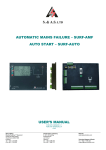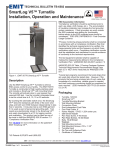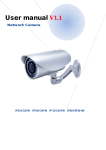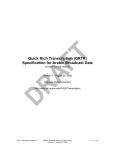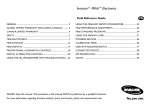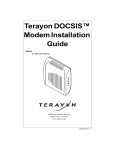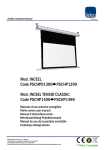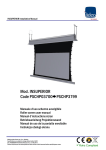Download Murphy Automatic Engine Controller A88 User`s manual
Transcript
S. & A.S. LTD AUTOMATIC MAINS FAILURE – SURF-AMF AUTO START – SURF-AUTO ENHANCED USER’S MANUAL FOR H/W VERSION 1.2A FOR S/W VERSION 2.00 1516 Beirut Office: Boutros Building 1st Basement Cheikh-el-Ghabi Street Ghabi Beirut 2068 7808 Lebanon Tel: +961 1 216 994 Fax:+961 1 339 600 Headquarters & Factory: S. & A. S. Building Seaside Road Jieh Chouf Lebanon Tel: +961 7 996 333 Fax:+961 7 996 116 Website: www.sascontrollers.com Technical Support & Email: Tel: +961 71 996 333 [email protected] -21 2 3 4 5 6 7 INTRODUCTION ...................................................................................................................................................... 3 FEATURES .............................................................................................................................................................. 3 OPERATION ............................................................................................................................................................ 3 PROGRAMMABLE OUTPUTS ............................................................................................................................... 4 PROGRAMMABLE INPUTS ................................................................................................................................... 5 COMMUNICATION PROTOCOLS.......................................................................................................................... 5 FAULT LOG ............................................................................................................................................................. 6 7.1 VIEWING THE FAULT LOG ........................................................................................................................... 6 7.2 ERASING THE FAULT LOG........................................................................................................................... 7 8 TIME SWITCH OPERATION ................................................................................................................................... 7 8.1 REMOTE CONTROL TERMINAL FUNCTION DESCRIPTION ..................................................................... 7 9 FRONT PANEL DESCRIPTION .............................................................................................................................. 7 9.1 MEASURED AND DISPLAYED PARAMETERS ........................................................................................... 7 9.2 FRONT PANEL LEDS ..................................................................................................................................... 7 9.3 DETECTED AND SIGNALED FAULTS AND WARNINGS ........................................................................... 8 9.3.1 WARNINGS ................................................................................................................................................. 8 9.3.2 FAULTS ....................................................................................................................................................... 8 9.4 DESCRIPTION OF STATUS MESSAGES SHOWN ON MULTIFUNCTION DISPLAY.............................. 10 9.4.1 FOR UTILITY () .......................................................................................................................................... 10 9.4.2 FOR GENSET ............................................................................................................................................ 10 10 REAR PANEL DESCRIPTION .............................................................................................................................. 11 10.1 TERMINAL DESCRIPTION........................................................................................................................... 11 10.2 LEDS DESCRIPTION .................................................................................................................................... 12 11 MENU DESCRIPTION ........................................................................................................................................... 12 12 TECHNICAL SPECIFICATION ............................................................................................................................. 14 13 FIRMWARE UPGRADE ........................................................................................................................................ 15 13.1 INSTALLING THE SURF FIRMWARE UPGRADE SOFTWARE ................................................................ 15 13.2 INSTALLING THE SURF USB DRIVER ....................................................................................................... 15 13.2.1 DRIVER SETUP FOR WINDOWS VISTA/WIN7 ..................................................................................... 15 13.2.2 DRIVER SETUP FOR WINDOWS XP ..................................................................................................... 17 13.3 FIRMWARE UPGRADE PROCESS ............................................................................................................. 18 14 CASE DIMENSIONS ............................................................................................................................................. 20 15 WIRING DIAGRAM................................................................................................................................................ 20 -31 INTRODUCTION This new genset controller series consists of two products: Surf-AMF and Surf-Auto. The Surf-AMF monitors the utility and controls the genset as well as the automatic transfer switch. The Surf-AUTO controls the genset only. However, the two controllers share many common features. Physically, the Surf has a very attractive and slim design. It features isolated measurement of the voltages and frequency on the two sources as well as the current on the load side. It has four user-selectable operating modes: Off, Auto, Utility Only(1) or Manual. Front panel LEDs signal the installation status and operating mode. The user interface consists of an LCD display for the measurements and faults. The front panel push buttons are provided to select the operating mode and to access a menu of parameters. The menu gives access to all timers, set points and other parameters relevant to the control and protection of the installation. The Surf series has a myriad of communication ports: CAN bus, Serial RS232C, USB, Ethernet and internet. The firmware could be easily upgraded on site via the USB interface. 2 FEATURES 3 Microcontroller based design Automatic mains failure or Auto Start controller Backlit liquid crystal display (LCD) Simultaneous display of AC voltage, currents, frequency, hour counter, oil pressure, engine temperature and battery voltage Display of power in KW and energy in KWh Display of fuel consumption rate (L/h), total fuel consumption and RPM (available only if CAN bus is supported by the engine) CAN bus J1939 enabled Ethernet interface USB interface Serial RS232S interface Internet communication: no software installation required Galvanic isolation for utility and genset AC inputs Parameters can be edited and updated from any remote interface at any time even when engine is running Menu accessible from front panel as well as USB, Ethernet and Serial Supports communication and SMS via GSM modem Supports 4-pole systems (Utility and Genset AC inputs are isolated) Operation by push buttons Easy to fit DIN standard 196x144 panel mount housing Connection is via locking plug and socket connectors Solid-state short circuit protected outputs Front panel LEDs for inputs status LCD symbols to display different alarms Automatic engine starting and stopping Automatic shutdown on fault condition Low oil pressure alarm and shut down High engine temperature alarm and shut down Dynamo fail alarm and shut down Low fuel alarm and shut down Over / Under speed alarm and shut down Low coolant level alarm and shut down Over / Under voltage alarm and shut down Overcurrent alarm and shut down Configurable I/Os OPERATION Four modes of operation are provided. Following is a description of each mode: 1 Off Mode: This mode is entered when the Off push button is pressed for more than 3 seconds. In this mode, the engine and the module are shut down. All faults and alarms are reset. Only Available for Surf-AMF -4 Manual Mode: This mode is entered when the Manual/Down push button is pressed. In this mode, the module will start the genset and engage the load. If, originally, Utility was feeding the load and the genset has no fault, Utility will continue feeding the load until the genset is done warming up(2). The load is disengaged and a transfer dead time(3) is counted before the genset engages the load. If the genset has a fault, then Utility would disengage the load immediately. Utility Only/Standby Mode: This mode is entered when the Utility/Select push button is pressed. In this mode, if Surf type is Surf-AMF, the Utility would feed the load when it is present. If Utility is absent or Surf type is Surf-AUTO, the genset will not be requested. If the genset was feeding the load before switching to this mode, the load will be disengaged. Auto Mode: This mode is entered when the Auto/Up push button is pressed. In this mode, Utility will feed the load if present. If Utility is absent, the genset will feed the load if no faults exist on it and if the remote control signal is active. If the genset was feeding the load and the remote control signal turns off, the genset would count the delay set by oFF (for Surf-AUTO) – MRT (for Surf-AMF) before disengaging the load. If the Utility is restored while the genset is feeding the load, Genset disengages the load after Restoration delay. Utility will engage after transfer dead time. Following is a description of the start sequence of the genset: 1. Once the remote control input receives a start signal, the response delay (set by RSP) is counted. 2. After the elapse of the response delay, the preheat relay (if present) is engaged for a time delay set by PRH. 3. A starting sequence of a preset number of attempts ATT will initiate. 4. The Electric Valve is engaged for 0.25 sec before the Starter. 5. If the start signal is removed before the engine starts, all timers are reset and the module is ready for a new sequence. 6. Cranking is disconnected when any of the following condition becomes valid: a. The measured frequency exceeds CrF. b. A voltage exceeding dcd (if not set to N) appears on the Dynamo input. c. The oil pressure switch opens (given that boP is not set to Y) and its preset delay has elapsed. d. The analog oil pressure measurement exceeded the value set by LoA (if not set to N). e. For Volvo engines, when a running indication is received through the CAN bus or the RPM exceeds 500. 7. If the engine fails to start after the preset number of attempts, the Alarm output is activated, the LCD alarm symbol ( ! ) blinks and the Multifunction Display on the LCD would indicate a start fail error (St Fail). Otherwise, the engine enters the running state and the running symbol ( ) turns on. 8. After elapse of the warm-up delay, set by WuP, the load contactor is engaged via terminal Contactor-G and the green load led is activated. If one of the Outputs is set to Cont-G2, then Cont-G2 would be engaged 5 seconds after the first Contactor. 9. All protections are enabled when the engine is running and after the elapse of the fault bypass time set by bYP. 10. Once a fault occurs, the load is shut down. Some faults require the engine to cool before shutting (high engine temperature, overload). Other faults would directly shut the engine. Alarm output and the corresponding fault symbol on the LCD are activated. The Multifunction Display would explain the fault. If CAN bus is enabled, the Multifunction display will show the DTC (J1939 protocol error code) description of the fault received from the CAN bus. 11. When the start signal on the genset is removed, the load is shut down after the elapse of the delay set by oFF (for Surf-AUTO) – MRT (for Surf-AMF). The engine is shut down after the elapse of the cooling time set by CoL. 4 PROGRAMMABLE OUTPUTS SURF has a total of six outputs (Output 1 6) that could be programmed to any of these functions: Preheat, Starter, Electric Valve, Utility Contactor, Genset Contactor, Alarm, Cut-off, Pre-alarm, Genset Contactor 2, Dummy Load, Overload, Start Fail and Auto Mode. Users can easily change the function of these outputs from the menu, parameters O1 O6. The user can also disable the output by setting the corresponding parameter to Not Assigned (N/A). Following is a description of each function: 2 3 Preheat (PRE) Function when one of the outputs is set to Preheat, the PRH parameter in the menu becomes visible and takes the default value 0. The preheat output is activated when the genset finishes counting the response delay and remains on for a delay set by PRH. Warm Up delay is presettable in the menu Transfer dead time is presettable in the menu -5- 5 Starter (STA) Function is activated while cranking the genset and remains on for a delay set by STA. The minimum value of STA is 1 sec if the oil pressure is bypassed otherwise the minimum value is the oil pressure bypass delay plus one second (boP+1). Electric Valve (EVA) Function if present should be defined at Output 2 since the dynamo excitation is physically connected to this output. To configure the Electric Valve at another output, the dynamo input should be connected to VBAT or the dynamo shutdown must be disabled (dSd set to N) if dynamo excitation is not required. Otherwise, the dynamo input should be externally excited. Utility Contactor (C-U) Function if present should be defined at Output 3. This output is activated when Utility engages the load and turns off when the load is released. Genset Contactor (C-G) Function if present should be defined at Output 4. This output is activated when the genset engages the load and turns off when the load is released. Alarm (ALA) Function is activated when a genset fault occurs. This output is not activated on emergency stop since it disables all outputs. Cut-Off (Cut) Function is activated when the genset should be shut down and it has finished cooling, when a fault that does not require cooling has occurred and the load was released or when the SURF module is turned off while the genset was on. When the cut-off output is activated, it will remain on until the delay set by Cut has elapsed. If the SURF module was turned off, the module can not be turned on until the cut-off delay has elapsed. The parameter Cut is not visible in the menu unless this output is activated. Pre-alarm (PRA) Function is activated on a pre-alarm condition caused by the analog measurements oil pressure/engine temperature dropping below/exceeding the pre-alarm level set in the parameters’ menu LoP/HTP. Genset Contactor 2 (CG2) Function is activated five seconds after the first genset contactor is engaged if the voltage and frequency readings are correct and there is no overload condition. If an overload occurs, this contactor is disengaged first and the load is measured again, if the overload condition persists then the contactor G is disengaged. Otherwise, Contactor G remains engaged. Contactor G2 re-engages when the load decreases. Dummy Load (dLd) Function is activated when the load remains below the level specified by doN for a delay set by dod. This output is disengaged when the load current exceeds the level specified by doF. Parameters doN, dod and doF are not visible unless this output is activated. Overload (oLd) Function is activated when the load exceeds the value set by oLd and the module is counting the overload delay set by oLdd or if an overload fault occurs. The output will be turned off if the load falls below oLd before the delay elapses. Start Fail (STF) Function is activated when the genset fails to start. This output is turned off when the start fail error is no longer present. The fault is removed when the Remote Control input is recycled or when Utility is restored. Auto Mode (AUT) Function is activated when the mode of operation is Auto. This output is turned off when the mode of operation is changed from Auto. PROGRAMMABLE INPUTS SURF has a total of five digital inputs (Input 1 5) that could be programmed to any of these functions: Oil Pressure Switch (oPS), Engine Temperature Switch (ETS), Oil Temperature Switch (oTS), Low Fuel Level Normally Open (LFo), Low Fuel Level Normally Closed (LFc) and Lamp Test (LMP). Users can easily change the function of these inputs from the menu, parameters I1 I5. The user can also disable the input by setting the corresponding parameter to Not Assigned (N/A). 6 COMMUNICATION PROTOCOLS SURF supports communication with the electronic control unit (ECU) on the genset using the J1939 CAN Bus protocol. Three different ECU types are supported: Standard Engine (SE), Volvo Engine (VE) and Perkins Engine (PE). Parameter ECU in the menu is used to select the ECU type. If the genset does not contain an ECU, set this parameter to No. The SURF module reads the following parameters from the CAN bus: oil pressure (PSI), engine coolant temperature (oC), fuel consumption (Liters/hour), engine speed (RPM), engine total hours of operation (Hr) and the engine total fuel consumption (L). -6Users can communicate with the SURF module by connecting it to a PC through an RS232 Serial Port, USB Port, Ethernet Port or a GSM Modem. When connecting from a PC, the program SURF Control allows the users to view and control the engine and to access the SURF parameters. When the parameter Mod is set to GSM, the user can also communicate with the SURF via SMS messages. To set up this feature, the following parameters must be set: 1. The identification of the SURF module (SITEId): This ID will be included as a header of all sent or received SMS messages. It must contain 6 digits which can be numbers (from 0 to 9) or letters (A to Z). Any message with a wrong ID will be ignored. 2. The phone number (PHONE): When a fault occurs, The SURF will send an SMS containing as a header the SURF ID followed by the fault description and all the readings at the time the fault occurred. This SMS is sent to the phone number specified by the user. The phone number must be between 3 and 18 digits long. Following is a description of the functions supported via SMS: Command Description Reset Delete Fault Log Switch to manual mode Switch to Auto mode Switch to Utility mode (AMF only) Switch to Standby mode (Auto only) View utility readings (AMF only) View generator readings Modify the parameters6 View the parameters8 SMS Format 4 SURF ###### reset5 SURF ###### dltfault SURF ###### manual SURF ###### auto SURF ###### utility SURF ###### standby SURF ###### umeasure SURF ###### gmeasure SURF ###### update parameter1=value1,parameter2=value2 7 Example: SURF SURF00 update A01=5,A03=32,A12=145,A31=0 SURF ###### request parameter1,parameter2,parameter3 Example: SURF SURF00 request A01,A03,A12,A31,A10 When modifying or viewing parameters through SMS, the SMS alias (refer to section 7) is used to identify the parameter being updated/requested. Thus, if the user wants to request the parameters RSP, Mod and ECU from the SURF having SiteID SURF00, the SMS would then be: “SURF SURF00 request a01,a66,a64”. Note that the parameters A64 to A76, A81 and A82 can be requested but cannot be modified through SMS. To set up the Ethernet module, the following parameters must be set: 1. The DHCP Module (dHC): If the network to which the SURF is being connected distributes IP addresses automatically, then the DHCP Module on the SURF must be enabled (dHC set to Y). If a fixed IP should be assigned to the SURF, then dHC should be set to N. 2. Network Configuration (IP Adr, SubNET, GATEWY): If dHC is set to N, the user must specify to the SURF: the IP Address (IP Adr), the Subnet Mask (SubNET) and the Default Gateway (GATEWY). 3. The identification of the SURF module (SITEId): the SITEId is used by the Ethernet module as a Net BIOS Name (NBNS). 7 FAULT LOG SURF has a Fault Log that can save the last 10 faults that occurred on the genset. The Fault Log saves the type of error that occurred along with the voltages, frequency, currents, oil pressure, engine temperature, battery voltage, hour meter, KW and KWHr. The Fault Log can be accessed and erased through the SURF menu or remotely through the different communication protocols supported. 7.1 VIEWING THE FAULT LOG To access the Fault Log, enter the menu (refer to section 7), scroll down until “VIEWFT” is displayed and press the SELECT push button. If no faults are saved, a “NO FLT” message is displayed. Otherwise, “FLT 1” is displayed. To scroll between the different saved faults, use the UP/DOWN push buttons. When the Fault Log is entered, the readings at the time of the fault are displayed instead of the current readings. The fault number, 4 SMS letters are not case sensitive. ###### being the SITEId. 6 Only 5 parameters can be modified in one SMS. 7 Parameter1, Parameter2 can take any value between A01 and A64 excluding A30. Value1, Value2 can take any value within the parameter’s value range. 8 Only 5 parameters can be viewed in one SMS. 5 -7type, KW and KWHr are displayed on the Multifunction display. To scroll between these readings, press the Menu push button. To exit the Fault Log, press the SELECT push button. 7.2 ERASING THE FAULT LOG To erase the Fault Log, enter the menu, scroll down until “ERSFLT” is displayed and press the SELECT push button. The SURF module prompts you to confirm your request by displaying the “RUSURE” message. To cancel the request, press the UP push button. To confirm the request, press the DOWN push button. 8 TIME SWITCH OPERATION The time switch manages the operating time of the genset , daily and weekly. Two parameters control the daily time switch: T-Rdy and T-sdby. T-Rdy sets the time at which the genset becomes ready. T-sdby sets the time at which the genset goes to standby mode. If genset is required to be in ready mode all day then set T-Rdy to ALLTIM (T-Sdby will no longer show). Rdyday controls the weekly operation. Under Rdyday, if ALL is set to Y then the genset will be ready all week long. Otherwise, the genset will be ready only in days set to Y. It will be in standby in days set to N. As a result, the genset will be ready during the hours set by T-Rdy and T-Sdby only on days set to Y under Rdyday. 8.1 REMOTE CONTROL TERMINAL FUNCTION DESCRIPTION In SURF-AMF with remote control set to RQS: when remote control is active, it overrides time switch setting and forces the genset into ready mode. In SURF-AMF with remote control set to SUP: when remote control is active, it overrides time switch setting and forces the genset into standby mode. In SURF-AUTO with remote control set to RQS: When remote control is active and genset in ready mode, the genset is started. Otherwise, the genset is stopped. In SURF-AUTO with remote control set to SUP: when remote control is active and genset in ready mode, the genset is stopped. 9 FRONT PANEL DESCRIPTION 9.1 MEASURED AND DISPLAYED PARAMETERS Voltage, current and frequency measurements correspond to the source feeding the load. The currents on the three phases are measured and displayed simultaneously using the following format. Current range 0 to 99.9A 100 to 999A 1000 to 1999A 2000 to 9999A 9.2 Format ##.# in A ### in A 1### in A #.## in KA The line-neutral and line-line voltages are all measured. The voltage displayed is either fixed on one voltage or allowed to scroll automatically between all six voltages (rn, sn, tn, rs, st, tr). The Menu push button is used to switch between the two display modes. The frequency is measured and permanently displayed. The hour meter is measured (or taken from the CAN bus if it is enabled) and permanently displayed. The engine temperature and oil pressure are measured (or taken from the CAN bus if it is enabled) and permanently displayed The battery voltage is measured and permanently displayed The Multifunction portion of the LCD displays the number of hours since the last oil change, the active power in KW for the source feeding the load, the energy in KWh for the genset, Utility and Genset status and the CAN readings: RPM, L/H, L, Add and DTC error messages. To start or stop scrolling between these messages, press the push button of the current operating mode. FRONT PANEL LEDS Four Leds are used to indicate the operating mode. Six input Leds used to indicate the status of the inputs. Utility supply has one red led. Led ON indicates that the Utility supply is within the acceptable limits, the phases are all present and in the right sequence. Led OFF indicates absence of Utility. Led blinking indicates an anomaly on the Utility. Utility contactor has one green led to show its status. -8 9.3 9.3.1 Genset has one red led. Led OFF means that the genset is not requested to start. Led blinking means that the genset has been requested to start or the genset is running with an anomaly. Led ON indicates that genset is running and ready to supply the load. Genset contactor has one green led to show its status. DETECTED AND SIGNALED FAULTS AND WARNINGS WARNINGS High Engine Temperature Warning occurs when the analog engine temperature sensor reading goes above the High Engine Temperature Pre-alarm value set by HTP in the menu or when the engine temperature switch is active and the 4 second fault delay is still being counted. The Engine Temperature symbol blinks indicating this warning. Low Coolant Level Warning occurs when the coolant switch is detected active and the 4 second delay is being counted. The Coolant Level symbol ( ) on the LCD blinks to indicate this warning. Low Oil Pressure Warning occurs when the analog reading goes below the Low Oil Pressure Pre-alarm value set by LoP in the menu or when the oil pressure switch is detected and the fault delay (2 sec) is being counted. The Oil Pressure symbol blinks indicating this warning. Low Fuel Level Warning occurs when the fuel switch is detected active and the 4 second delay is being counted. The Fuel Level symbol ( ) on the LCD blinks to indicate this warning. Low Dynamo Voltage Warning occurs when the dynamo voltage decreases below the dynamo shutdown voltage set by dSd and the 5 second delay is being counted. The Dynamo Voltage ( ) symbol on the LCD blinks to indicate this warning. Over/Under Frequency Warning occurs when the frequency goes above/below the values set in GoF/GuF (for Genset), UoF/UuF (for Utility) and the delay set by GoFd/GuFd (for Genset), UoFd/UuFd (for Utility) is being counted. For the genset, the RPM symbol ( ) turns on to indicate this warning. Oil Change Warning occurs when the hours since last oil change exceed the value set by RHR. This warning is indicated by the blinking of the Oil Pressure symbol on the LCD. To reset the oil change counter, press the push button corresponding to the current operating mode for 2 seconds. 9.3.2 FAULTS To delete the current fault, press and release the Off push button. Fault Fail to start Emergency stop High Battery Low Battery High Engine Temp. High Oil Temp. Low Coolant Level Low Oil Pressure Low Fuel Level Low Dynamo Volt Genset Over Voltage Genset Under Voltage Genset Phase Failure Genset Sequence Failure Genset Over Frequency Comments Genset Under Frequency Over Load Utility Over Voltage Utility Under Voltage Utility Phase Failure Utility Sequence Failure Utility Over Frequency Utility Under Frequency Shuts the load and engine after the elapse of the over frequency delay (GuFd) Genset fails to start after the maximum number of attempts was reached Shuts load, engine and all outputs immediately Shuts load and engine after the elapse of the High Battery delay (Hbd) Shuts load and engine after the elapse of the Low Battery delay (Lbd) Shuts load and engine due to high engine temperature Shuts load and engine due to high oil temperature Shuts load and engine due low coolant level Shuts load and engine due to low oil pressure Shuts load and engine due to low fuel level Shuts load and engine due to low dynamo voltage Shuts the load and engine after the elapse of the over voltage delay (GoVd) Shuts the load and engine after the elapse of the under voltage delay (GuVd) Shuts load and engine due to a phase failure Shuts engine due to a sequence failure Symbol ! ! ! ! ! ! ! ! ! Shuts the load and engine after the elapse of the over frequency delay (GoFd) Shuts the load and engine after the elapse of the over load delay (oLdd) Shuts the load after the elapse of the over voltage delay (UoVd) Shuts the load after the elapse of the under voltage delay (UuVd) Shuts load due to a phase failure Utility anomaly due to sequence failure Shuts the load after the elapse of the over frequency delay (UoFd) Shuts the load after the elapse of the over frequency delay (UuFd) -------- -9Fail to Start Fault occurs when the engine does not turn on after ATT cranking attempts. ATT is set in the menu. The fault is removed when the Remote Control input is recycled or when Utility is restored. The fault symbol ( ! ) blinks and the Multifunction display indicates a start fail fault by displaying St Fail in the Genset Status page. Emergency Stop occurs when the emergency switch is turned off. All the outputs from the SURF will be disabled, the fault symbol ( ! ) turns on and the Multifunction display indicates the fault by displaying E-StoP in the Genset Status page. High Battery Fault occurs when the battery voltage exceeds Hib for a delay set by Hbd. The fault symbol (!) turns on and the Multifunction display indicates a high battery fault by displaying bat-Hi in the Genset Status page. Low Battery Fault occurs when the battery voltage drops below Lob for a delay set by Lbd. This fault is tested when the engine is not cranking and independent of the fault bypass delay. The fault symbol (!) turns on and the Multifunction display indicates a low battery fault by displaying bat-Lo in the Genset Status page. High Engine Temperature Fault occurs when the engine temperature switch is detected on for 4 seconds or when the analog engine temperature sensor reading goes above the High Engine Temperature Alarm value set by HTA in the menu. The Engine Temperature symbol ( ) turns on and the Multifunction display shows Fault in the Genset Status page. Genset goes into cooling if CHT is set to Y. High Oil Temperature Fault occurs when the oil temperature switch is detected on for 4 seconds. The fault symbol ( ! ) turns on and the Multifunction display indicates a high oil temperature fault by displaying Hi-Oil T in the Genset Status page. Low Coolant Level Fault occurs when the coolant switch is detected active for 4 seconds. The Coolant Level symbol ( ) on the LCD turns on and the Multifunction display shows Fault in the Genset Status page. Low Oil Pressure Fault occurs when the oil pressure switch is detected on for 2 seconds or when the analog oil pressure sensor reading goes below the Low Oil Pressure Alarm value set by LoA in the menu. The Oil Pressure symbol ( ) turns on and the Multifunction display shows Fault in the Genset Status page. Low Fuel Level Fault occurs when the fuel switch is detected active for 4 seconds. The Fuel Level symbol ( ) on the LCD would turn on and the Multifunction display shows Fault in the Genset Status page. Low Dynamo Voltage Fault occurs when the dynamo voltage decreases below the dynamo shutdown voltage set by dSd for 5 seconds. The Dynamo Voltage ( ) symbol on the LCD turns on and the Multifunction display shows Fault in the Genset Status page. Over/under Voltage Fault occurs when one of the three-phase voltages goes above/below the over/under voltage limits set by GoV/GuV (for Genset), UoV/UuV (for Utility) for a delay of GoVd/GuVd(for Genset), UoVd/UuVd (for Utility). The Multifunction display indicates an over/under voltage fault by displaying oVolt/uVolt in the Genset Status page or U-VX in the Utility Status page. If the fault occurs on the genset, the fault symbol ( ! ) turns on. Phase Failure Fault occurs when the voltage on one of the lines falls below 100V or the voltage difference between any two phases exceeds 120V or the frequency goes below 15Hz. The Multifunction display indicates the fault by displaying Ph Fail in the Genset Status page or U- VX in the Utility Status page. If the fault occurs on the genset, the fault symbol ( ! ) turns on. Sequence Failure Fault occurs when the phases are reversed. The Multifunction display indicates the fault by displaying SQ Fail in the Genset Status page or U- SX in the Utility Status page. If the fault occurs on the genset, the fault symbol ( ! ) turns on. Over/Under Frequency Fault occurs when the frequency goes above/below the values set in GoF/GuF (for Genset), UoF/UuF (for Utility) for a delay of GoFd/GuFd (for Genset), UoFd/UuFd (for Utility). The Multifunction display indicates an over/under frequency fault by displaying oFREQ/uFREQ in the Genset Status page or U-FX in the Utility Status page. For the genset, the RPM symbol ( fault and blink for an over frequency fault. ) turns on for an under frequency Overload Fault occurs when the load on the genset exceeds the value set by oLd for a delay set by oLdd. The fault symbol ( ! ) turns on and the Multifunction display indicates an overload fault by displaying oVLoad in the Genset Status page. Genset goes into cooling if CHT is set to Y. -109.4 9.4.1 DESCRIPTION OF STATUS MESSAGES SHOWN ON MULTIFUNCTION DISPLAY FOR UTILITY (9) Status Message U-AbSt U-RdY U- VX U- FX U- SX U-W 10 U-X 10 U-OnLd 9.4.2 FOR GENSET Status Message StndbY REAdY NotRdY RSP 10 PHT 10 (10) CRANKG RUNING WUP 10 XFR 10 OnLoad SLd 10 CoL 10 SEG 10 (11) Fault Hi-Oil T E-StoP St Fail Ph Fail SQ Fail bat-Hi bat-Lo oFREQ uFREQ oVolt uVolt oVLoad -----L ----rPM ---L/H ---Add 9 Description Utility is Absent Utility is Ready Utility Voltage error (Over/under voltage, phase failure) Utility Frequency error (Over/under frequency) Utility Sequence error Utility is being restored with count down Utility is counting Transfer Dead Time with count down Utility is Feeding Load Description Genset ready but Remote Control is absent Genset ready Genset not ready Engine Counting Response delay with count down Engine Preheating with count down Engine Cranking Engine running Engine Warming Up with count down Engine counting Transfer Dead Time with count down Engine running on load Engine Shutting Load with count down Engine Cooling with count down Shutting Engine with count down A fault has occurred on the Genset High oil temperature Fault Emergency stop Fail to start Fault Genset Phase failure Fault Genset Sequence failure Fault High battery Fault Low battery Fault Genset Over frequency Fault Genset Under frequency Fault Genset Over voltage Fault Genset Under voltage Fault Overload Fault Fuel Level (Available only when CAN is enabled) Rounds per minute (Available only when CAN is enabled) Fuel Consumption Rate (Available only when CAN is enabled) CAN Address (Available only when CAN is enabled) Available only for Surf-AMF Available only if one of the outputs is set to Preheat 11 Available only if one of the outputs is set to Cut-Off 10 -1110 REAR PANEL DESCRIPTION 10.1 TERMINAL DESCRIPTION CONNECTOR P1 1 TERMINAL 2 3 4 5 6 -VBAT SUP +VBAT SUP VBAT POW OUTPUT 1 OUTPUT 2 OUTPUT 3 P2 OUTPUT -ve battery supply 7 +ve battery supply 8 After emergency stop and fuse 9 Output 1 (Starter) 10 DYN EXC Dynamo excitation Output 2 (Fuel Electric Valve) 11 CAN H CAN High line Output 3 (Utility Contactor) 12 CAN L CAN Low Line 4 OUTPUT 5 OUTPUT 6 Output 4 (Genset Contactor) Output 5 (Alarm Output) Output 6 (Genset Contactor 2) CONNECTOR P3 13 TERMINAL 14 15 16 17 18 REF SENS AN INPUT 1 AN INPUT 2 AN INPUT 3 AN INPUT 4 LCL P4 Reference sensor input 19 Analog Input 1 (Oil pressure sensor input) Analog Input 2 (Engine temperature sensor input) 20 21 Analog Input 3 (Not Assigned) 22 Analog Input 4 (Not Assigned) 23 Low Coolant Probe 24 RMTE CNTRL INPUT 1 INPUT 2 INPUT 3 INPUT 4 INPUT 5 Remote control input Input 1 (Oil pressure switch) Input 2 (Engine temperature switch) Input 3 (Oil temperature switch) Input 4 (Low Fuel level Normally Open) Input 5 (Lamp Test) CONNECTOR TERMINAL P5 25 LINE RU Line R – U supply 26 NOT USE 27 31 Line R – G supply Not used 32 NOT USE Not used LINE SU Line S – U supply 33 LINE SG Line S – G supply 28 NOT USED Not used 34 NOT USED Not used 29 LINE TU Line T – U supply 35 LINE TG Line T – G supply 30 N U Neutral – U supply 36 N G Neutral – G supply CONNECTOR P7 TERMINAL P6 LINE RG 37 CT R P1 Current transformer on line R – p1 38 CT R P2 Current transformer on line R – p2 39 CT S P1 Current transformer on line S – p1 40 CT S P2 Current transformer on line S – p2 41 CT T P1 Current transformer on line T – p1 42 CT T P2 Current transformer on line T – p2 -1210.2 LEDS DESCRIPTION Led No. 1 2 3 4 5 6 11 Color Green Red Red Red Red Red Input configuration Remote Control signal IP1 signal IP2 signal IP3 signal IP4 signal IP5 signal Correspondent factory configuration Remote Control signal Oil pressure signal Engine temperature signal Oil temperature signal Low Fuel level Normally Open signal Lamp Test signal MENU DESCRIPTION Follow the steps described below to access the menu: 1. Press the Menu Push button for three seconds: The alphanumeric characters on the LCD would display “PSW – “. You will be prompted to enter a three-digit code. The default password is 000. 2. Use the UP and DOWN push buttons to scroll to the desired number. 3. Press the SELECT push button. “*” replaces the first digit. 4. Repeat steps 2. and 3. until all three digits are entered. If the entered password is valid, the user will have access to the menu below. If no push buttons are pressed for 5 minutes while in the menu, the system will automatically exit the menu. The SMS Alias column in the table represents the SMS code to use when modifying the parameter through SMS. In the Range column below, the number between brackets is the one to use when the parameter is being modified through SMS. SMS Alias A01 A02 A03 A04 A05 A06 A07 A08 A09 A10 A11 A12 A13 A14 A15 A16 A17 A18 A19 A20 A21 A22 A23 A24 A25 A26 A27 A28 A29 A31 A32 A33 A34 A35 A36 Display Parameter Description Range Factory setting RSP PRH STA bET ATT bYP WuP MRT oFF XFR CoL Cut CrF UoF UoFd UuF UuFd UoV UoVd UuV UuVd GoF GoFd GuF GuFd GoV GoVd GuV GuVd CT oLd oLdd doN dod doF boP Response delay Preheat delay Starter time Time between trials Number of Attempts Fault bypass delay Warm-up delay Mains Restoration delay (AMF only) Off delay (AUTO only) Transfer dead time (AMF only) Cooling delay Cut-Off time Crank Disconnect Freq. Utility Over Frequency (AMF only) Utility Over Freq. delay (AMF only) Utility Under Frequency (AMF only) Utility Under Freq. delay (AMF only) Utility Over Voltage (AMF only) Utility Over Volt. delay (AMF only) Utility Under Voltage (AMF only) Utility Under Volt. delay (AMF only) Genset Over Frequency Genset Over Freq. delay Genset Under Freq. Genset Under Freq. delay Genset Over Voltage Genset Over Volt. delay Genset Under Voltage Genset Under Volt. delay Current Transformer ratio Overload % Overload delay Dummy load engage set point Dummy load engage delay Dummy load disengage set point Bypass OPS 0 to 255 sec 0 to 255 sec 0 to 255 sec 0 to 255 sec 0 to 255 0 to 255 sec 0 to 255 sec 5 sec 0 sec 5 sec 12 sec 3 Att 15 sec 10 sec 0 to 255 sec 10 sec 0 to 255 sec 0 to 255 sec N (0), 1 to 255 sec 0 to 255 Hz N (0), 1 to 255 Hz 0 to 99 sec N (0), 1 to 255 Hz 0 to 99 sec N (0), 1 to 255 V 0 to 99 sec N (0), 1 to 255 V 0 to 99 sec N (0), 1 to 255 Hz 0 to 99 sec N (0), 1 to 255 Hz 0 to 99 sec N (0), 1 to 255 V 0 to 99 sec N (0), 1 to 255 V 0 to 99 sec 0/5 to 9999/5 N (0), 1 to 255% 0 to 99 sec N (0), 1 to 255 % 0 to 255 sec N (0), 1 to 255 % Y (0),1 to 5 sec 0 sec 30 sec 10 sec 15 Hz 55 Hz 2 sec 45 Hz 5 sec 240 V 3 sec 200 V 5 sec 55 Hz 2 sec 45 Hz 5 sec 240 V 3 sec 200 V 5 sec 100/5 90% 10 sec 10% 30 17% 1 sec -13SMS Display Alias Parameter Description Range Factory setting A37 oPS Oil Pressure Sensor type V1=VDO type 1 (0) V5=VDO type 2 (1) MU=Murphy (2) V1 A38 A39 LoP LoA Low Oil Pressure Pre-alarm Low Oil Pressure Alarm N (0), 1 to 255 PSI N (0), 1 to 255 PSI N N A40 ETS Engine Temperature Sensor type V1=VD0-1 (0) V2=VD0-2 (1) MU=Murphy (2) PT=PT100 (3) V1 A41 A42 A43 A44 A45 A46 A47 A48 A49 A50 HTP HTA CHT dcd dSd Hib Hbd Lob Lbd LcL High Engine Temp Pre-alarm High Engine Temp Alarm Cooling After High Temperature Dynamo Crank Disconnect Dynamo Shut Down High Battery High Battery Delay Low Battery Low Battery Delay Low Coolant Level N (0), 1 to 255 oC N (0), 1 to 255 oC N (0),Y (1) N (0), 10 to 26 V N (0), 5 to 10 V N (0), 1 to 255 V 0 to 255 sec N (0), 1 to 255 V 0 to 255 sec Nc (0), No (1) N N Y 10 V 10 V 30 V 3 sec 8V 2 sec No STA EVA C-U C-G ALA CG2 A51 O1 Output 1 N/A=Not Assigned (0) PRE=Preheat (1) STA=Starter (2) EVA= Evalve (3) C-U=Cont-Utility (4) C-G=Cont-genset (5) ALA=Alarm (6) Cut=Cut Off (7) PRA=PreAlarm (8) CG2=Cont-Gstep2 (9) dLd=Dummy Ld (10) oLd=Overload (11) STF=StartFail (12) AUT=Auto Mode (13) A52 A53 A54 A55 A56 O2 O3 O4 O5 O6 Output 2 Output 3 Output 4 Output 5 Output 6 (same as above) (same as above) (same as above) (same as above) (same as above) A57 RC Remote Control A58 I1 Input 1 A59 A60 A61 A62 A63 I2 I3 I4 I5 RHR A64 ECU12 A65 A66 APP IDL Input 2 Input 3 Input 4 Input 5 Run Hour Engine Electronic Control Unit Type (cannot be modified when engine is running ) Accelerator Pedal Position13 Idle Speed Delay13 12 13 RoS= Request Genset On Signal (0) SUP= Simulate Utility Present (1) N/A=Not Assigned (0) oPS=Oil Pressure (1) ETS=Engine Temp. (2) oTS=Oil Temp. (3) LFo=Low Fuel No (4) LFc=Low Fuel Nc (5) LMP=Lamp Test (6) (same as above) (same as above) (same as above) (same as above) N (0), 1 to 255 hr. No=No control unit (0) SE=Standard engine (1) VE=Volvo Engine (2) PE=Perkins Engine (3) 0 to 100 % N (0),1-99 To enable ECU, boP parameter must be set to Y (ECU cannot be modified when SURF is showing “NotRdy”) These parameters are only available when ECU type is Volvo and cannot be modified when engine is running GRd oPS ETS oTS LFo LMP 150 hr. No 50% N -14SMS Display Alias Parameter Description Range Factory setting A67 SPD Speed Select13 PRI=Primary speed (0) SEC=Secondary speed (1) PRI A68 UPW User Password 000 to 999 000 No=no modem (0) LM=Line modem (1) GSM=GSM modem (2) No A69 Mod Modem Type A70 A71 A72 A73 A74 A75 PHONE SITEId dHC IP Adr SubNET GATEWY Phone Number Identification Code DHCP Enabled IP Address Subnet Mask Default Gateway A76 UPH Utility Connection (AMF & AMF/ES only) A77 GPH Genset Connection A78 A79 dATE TIME Set the date Set the time A80 T--RdY Set the genset ready time 14 A81 A82 A83 A84 A85 A86 A87 A88 A89 A90 A91 T--SdbY RdYdAY ALL SUN15 MON15 TUE15 WED15 THU15 FRI15 SAT15 WEX16 Set the genset standby time Set the genset ready days A92 S--NAME Server name A93 A94 A95 - S--IP HR. KWh ERSFLT VIEWFT EXIT Server IP Address Modify Hour meter (only if ECU=No) Modify KWhour Erase Fault Log View Fault Log Exit Menu 12 Weekly exercise (3 to 18 digits) (6 digits or letters) N (0),Y (1) ---.---.---.-----.---.---.-----.---.---.--3PH=3 phase (0) 1PH=1 phase (1) 3PH=3 phase (0) 1PH=1 phase (1) DD.MM.YY ##h##P or ##h##A ALLTIM, ##h##P or ##h##A ##h##P or ##h##A N (0),Y (1) N (0),Y (1) N (0),Y (1) N (0),Y (1) N (0),Y (1) N (0),Y (1) N (0),Y (1) N (0),Y (1) N (0),Y (1) ---.---.---.--0 to 65530 0 to 999999 ------- 0 SURF00 N 192.168.0.21 255.255.255.0 192.168.0.1 3PH 3PH N Y Y Y Y Y Y Y N www.sascontrollers. com 69.167.158.129 000000 000000 ------- TECHNICAL SPECIFICATION Supply voltage range Maximum supply current Standby supply current Digital inputs activation logic Solid-State Output rating AC inputs range (L-N) CT inputs range Operating temperature User access Data sampling rate Dimensions Panel cut out 14 15 16 5 to 33Vdc 180mA 56mA Low (ground) 1A 50V 0 to 256Vac 0 to 5A -30 to 70C Five push buttons 0.4samples/sec 196x144x33 182x137 Appears only if T—Rdy is set to time Appears only if ALL is set to N When enabled, if generator did not operate between Sunday and Friday, it would be started on Saturday at 8:00 am for half an hour -1513 FIRMWARE UPGRADE 13.1 INSTALLING THE SURF FIRMWARE UPGRADE SOFTWARE In order to upgrade firmware on site, a CD will be provided by S.&A.S.Ltd & the below steps shall be followed: 1. Run file “SAS_Patch.exe” located in “Surf120_PTool\SAS_PTool” folder. 2. Setup the application located in “Surf120_PTool\SAS_PTool \SAS_PTool_Setup” folder 3. SAS_PTool will appear in the programs list. Send it to Desktop as shortcut. 13.2 INSTALLING THE SURF USB DRIVER 1. Plug in the USB cable to the SURF device before turning power on 2. Turn on power of the SURF device. All the leds on the front starts blinking. 13.2.1 DRIVER SETUP FOR WINDOWS VISTA/WIN717 The first SURF plugged into the PC USB port may not launch an automatic start. In this case, right-click my computer and choose properties. The following window appears. On the left side of the window, click on Device Manager. 17 This will be implemented only one time when the first Surf is connected to PC through USB. -16The “SAS DEV” device will appear in Other Devices, right-click it and choose Update Driver Software. Select “Search automatically for updates driver software”. -17Select Install this driver software anyway. The Driver SETUP procedure will be done only once For Windows vista/Win7. So, the driver of any new SURF connected to the PC USB port will be installed automatically. 13.2.2 DRIVER SETUP FOR WINDOWS XP Each time new SURF is plugged into the PC USB port, a “Found New Hardware Wizard” window appears. Select “Install the software automatically (Recommended)” and click next. -18Select “Continue Anyway”. The driver of the new SURF connected to the PC USB port will be installed automatically. 13.3 FIRMWARE UPGRADE PROCESS Run “SAS_PTool” application. The following window will appear prompting the user that the SURF board is detected on the USB port: Click Open to choose the *.sas file that will be used to upgrade the firmware. A Footnote will appear showing the file name, the software version and its date: -19- Click upgrade. The upgrade progress is shown as below: Once the upgrade is complete, the footnote “Firmware upgraded successfully” will appear: Then the SURF Firmware upgraded successfully and the SURF will automatically run the new firmware. -2014 CASE DIMENSIONS 5.0 mm 11.0 mm 19.0 mm 22.0 mm 196.0 mm 181.0 mm P7 37 136.0 mm P5 25 29.5 mm P6 31 39.0 mm 15 1 7 13 19 P1 P2 P3 P4 6.0 mm WIRING DIAGRAM This section contains the wiring diagram of the SURF-AMF and SURF-AUTO. 19.0 mm 6.0 mm 144.0 mm 136.0 mm 18.0 mm 12.0 mm 5 - 33 Vdc 5 6 7 8 9 10 11 12 *: Connected to battery -ve on the engine body NB: R(Alarm), R(G Ld2), R(U Ld), R(G Ld), R(St) and R(EV) relays should all be DC relays with their coil voltage equal to the battery voltage 1 1 I5 (LMP) I4 (LFO) I3 (OTS) I2 (ETS) I1 (OPS) REMOTE CONTROL COOLANT PROBE ANALOG INPUT 4 ANALOG INPUT 3 ANALOG INPUT 2 ANALOG INPUT 1 REF SENSOR 1 LMP 4 LFO 3 OTS 2 CAN_L 2 ETS 1 OPS LINE R G TEMPERATURE SENSOR LINE S G CAN_H 2 OIL PRESSURE SENSOR 31 LINE S U CAN_L 26 DYNAMO LINE T U CAN_H 32 O6 (G CONT. 2) NEUTRAL U 29 2 DYNAMO EXCITATION 33 O5 (ALARM) LINE T G O4 (G CONT.) 30 10 R(G Ld2) 2 2 1 10 2 N CT T P2 1 R(Alarm) 2 34 O3 (U CONT.) 2 T 10 R(G Ld) 2 1 CT T P1 1 S 2 NEUTRAL G 35 O2 (E. VALVE) R 10 2 CT S P2 1 R(U Ld) 2 36 O1 (STARTER) N CT S P1 2 CT R P2 CT R P1 FUSE FUSE 1 10 R(EV) LINE R U VBAT POWER 25 (+)Vbat 27 (-)Vbat R(G Ld) R(U Ld) T 2 C(U Ld) C(G Ld) 2 10 10 10 2 1 FUSE C(G Ld) C(U Ld) 1 S 2 R(St) 2 2 G R S T LOAD R N 37 38 39 40 41 42 28 SURF AMF 13 14 15 16 17 18 19 20 21 22 23 24 * 2 5 6 7 8 9 10 11 12 NB: R(Alarm), R(G Ld2), R(U Ld), R(G Ld), R(St) and R(EV) relays should all be DC relays with their coil voltage equal to the battery voltage *: Connected to battery -ve on the engine body LMP 4 LFO 3 OTS 2 ETS 1 I5 (LMP) I4 (LFO) I3 (OTS) I2 (ETS) I1 (OPS) REMOTE CONTROL COOLANT PROBE ANALOG INPUT 4 ANALOG INPUT 3 ANALOG INPUT 2 ANALOG INPUT 1 REF SENSOR CAN_L CAN_H 2 OPS O6 (G CONT. 2) CT T P2 CT T P1 N TEMPERATURE SENSOR O5 (ALARM) LINE R G DYNAMO O4 (G CONT.) CT S P2 2 OIL PRESSURE SENSOR CAN_L CAN_H 10 R(G Ld2) 10 R(G Ld) 2 O3 (U CONT.) 2 DYNAMO EXCITATION 10 R(Alarm) 2 5 - 33 Vdc 10 2 CT S P1 1 CT R P2 CT R P1 FUSE T R(U Ld) 2 31 LINE S G O2 (E. VALVE) 32 O1 (STARTER) R(G Ld) 2 10 R(EV) 10 2 1 2 33 10 C(G Ld) 1 S 2 R(St) LINE T G VBAT POWER 34 (+)Vbat NEUTRAL G 35 (-)Vbat 36 FUSE 2 G R 1 1 S 1 T N 37 38 39 40 41 42 SURF AUTO 13 14 15 16 17 18 19 20 21 22 23 24 * LOAD R






















